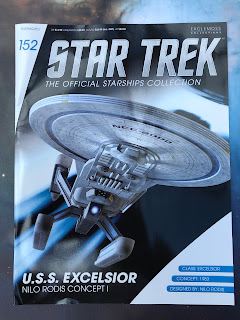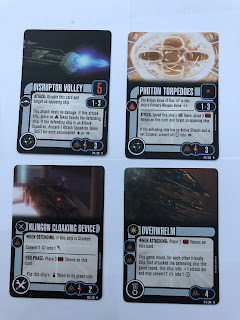Now updated to include Discovery, Larry Nemecek's Star Trek Stellar Cartography is back and better than ever.
Comprising of ten A2 maps illustrated by Ian Fullwood, Ali Ries and Geoffrey Mandel and an accompanying book, the collection comes in a swanky fold out tome to keep it all in perfect condition.
There are a couple of oddball ones in here such as the Vulcan interpretation of their home system as well as the Klingon and Romulan empires in their own languages and styles. These three are the more "artistic" of the fold out maps and while they look authentic to their respective civilisations, they do leave you a little miffed as to what is where and why.
Good thing then that this collection also includes a series of maps detailing the Alpha and Beta Quadrants with irascible scrutiny. In fact in the case of a couple of them there's a stupid amount of information to take in that covers all bases from The Original Series right up to the first season of CBS' Discovery. There's also Known Space, the Cardassian Union, the Dominion War and more to pour over.
Each map, be it the rather artsy Vulcan one or the more detailed Federation editions is neatly stored ready for review within the book and is accompanied by an explanation to their creation and interpretation thanks to a slim companion volume which sits dead centre in the impressive presentation box. While each of the maps provides something very different to pour over for hours (especially a certain couple of them), the book backs up just why certain areas look the way they do or the reasons behind the way the civilisations have chosen to display their understanding of the cosmos in various ways.
The clever bit is having the scope to envision just how the Romulans would extrapolate their star systems or how the Vulcans would represent their homeworld and Larry Nemecek has done a sterling job making each one distinctive and memorable. The themes are all very individualistic with the Klingon maps functional and stark contrasting to those smooth curves of the Vulcan images which has an almost musical, sensual feel to it.
That said there are a couple of the maps which are heads above the rest of the content and these are the foldouts which show Federation space and detail events from the past 50 odd years of the franchise, recounting the path of V'Ger, the location of the Mutara Nebula, precisely where USS Constellation was lost to the Planet Killer and even pinpoints The Battle of the Binary Star from the very latest show, Discovery which I think makes this the first piece of behind the scenes literature from the franchise to do so.
The detail on these Federation maps is mind-blowing and I've gone over them more than a couple of times and on each occasion there's been something new I've caught, another route I've uncovered or episode that I've flipped back to and realised how close location-wise it was to another event from a few decades later.
At the centre of this tri-fold behemoth of a work there's a handy, smaller guide which contains page size versions of the maps plus background and explanations around their appearance in galactic history and details on key civilisations featured within.
The work in this book/collection/tome is amazing and there's always something else and another angle to look at it from. Truly a wonderfully presented and researched work that any fan should have in their library and a resource that will cause many a referential argument - or be the source of the correct answer - for many, many years to come. I for one know this is going to get a lot of use and suspect that there will have to be a fair few more updates with all the new Star Trek series coming out in the next few years....that's a lot more dots and lines to fit on to the maps!
The accompanying book is much easier to use for quick reference yet there's something much more engrossing about looking at the fullblown, unfolded maps when you get the chance. Certainly a lot clearer to scrutinise the detail!
When I briefly caught Larry at Destination Star Trek last year (his second time at the event), he was working on his Portal 47 project plus continuing efforts on Trekland as well as the location tours in Los Angeles plus promoting the updated (and rather spiffing) Star Trek Stellar Cartography. Definitely a man with a lot to do and here's hoping that the next thing we get to see is the completed Con of Wrath!
Star Trek: Stellar Cartography is available now from all decent sci-fi selling bookshops, online retailers and the like priced RRP £35 ISBN 978-0-7603-6381-2.
At the centre of this tri-fold behemoth of a work there's a handy, smaller guide which contains page size versions of the maps plus background and explanations around their appearance in galactic history and details on key civilisations featured within.
The work in this book/collection/tome is amazing and there's always something else and another angle to look at it from. Truly a wonderfully presented and researched work that any fan should have in their library and a resource that will cause many a referential argument - or be the source of the correct answer - for many, many years to come. I for one know this is going to get a lot of use and suspect that there will have to be a fair few more updates with all the new Star Trek series coming out in the next few years....that's a lot more dots and lines to fit on to the maps!
The accompanying book is much easier to use for quick reference yet there's something much more engrossing about looking at the fullblown, unfolded maps when you get the chance. Certainly a lot clearer to scrutinise the detail!
When I briefly caught Larry at Destination Star Trek last year (his second time at the event), he was working on his Portal 47 project plus continuing efforts on Trekland as well as the location tours in Los Angeles plus promoting the updated (and rather spiffing) Star Trek Stellar Cartography. Definitely a man with a lot to do and here's hoping that the next thing we get to see is the completed Con of Wrath!
Star Trek: Stellar Cartography is available now from all decent sci-fi selling bookshops, online retailers and the like priced RRP £35 ISBN 978-0-7603-6381-2.
Follow us on Twitter
Add us on Tumblr





































